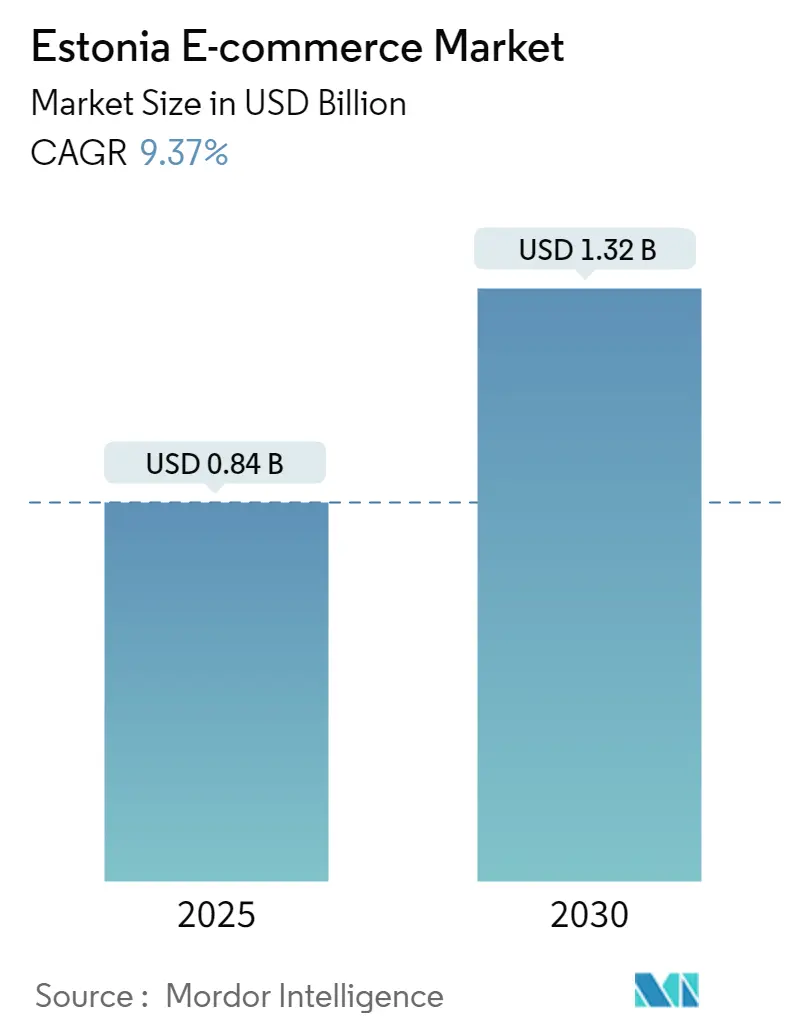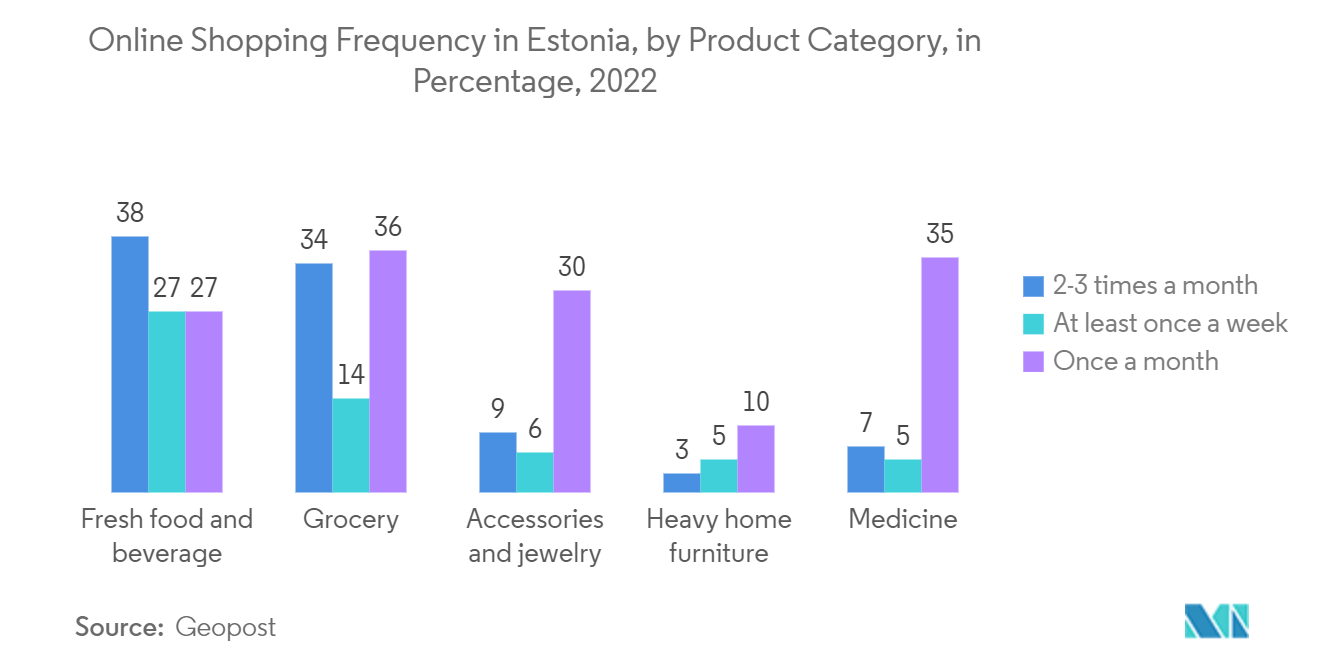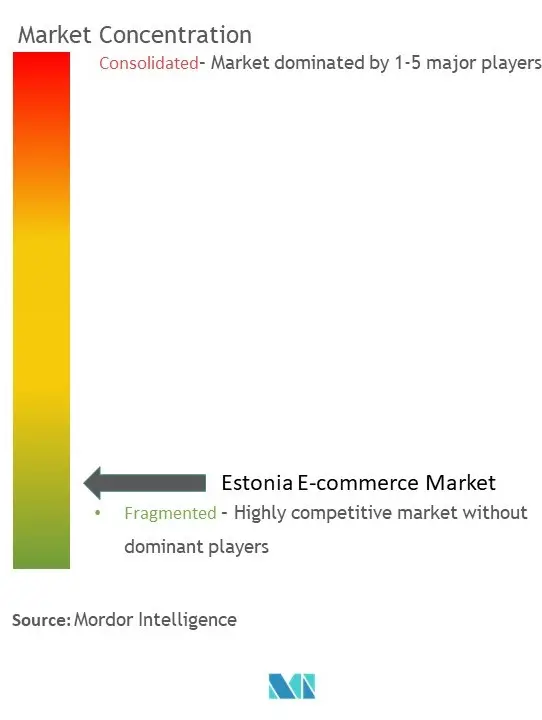Estonia E-Commerce Market Analysis
The Estonia E-commerce Market size is estimated at USD 0.84 billion in 2025, and is expected to reach USD 1.32 billion by 2030, at a CAGR of 9.37% during the forecast period (2025-2030).
E-commerce emerged as a prominent consumer choice to purchase goods during the last decade. The rising internet penetration, growing access to the internet across the populations in developing economies, increasing smartphone penetration, advancements in technology, and rapid urbanization created a massive opportunity for the e-commerce market.
- The e-commerce sector is taking advantage of opportunities across a variety of landscapes, driven by young demographic profiles, rising internet usage, and generally better economic performance in recent years.
- The consumer electronics, personal care, and fashion and apparel sectors are principally responsible for the market's expansion. There is potential for developing prospects thanks to significant expenditures in the consumer electronics, personal care, and fashion and clothing industries.
- One of the biggest trends in online retail is platform convergence. Customers prefer an all-in-one shopping experience that includes product ratings and prices, buying, and making payments using the platforms' new online payment options. Consequently, online shopping features are available on portal websites, social media, TV home shopping, over-the-top media services (OTT), etc. As a result, their platforms are becoming more popular.
- E-commerce enterprises generally store customers' bank accounts and credit card information. Email addresses, mailing addresses, usernames, and passwords are usually held by e-commerce enterprises, subjecting them to cybersecurity attacks. Cybercriminals profit from this information by duplicating credit cards and utilizing users' personal information for identity theft and fraud. Hackers may potentially hold sensitive data hostage for ransom.
- Furthermore, the supply chain of the e-commerce market was largely disrupted due to the COVID-19 pandemic. Despite creating new opportunities for growth in terms of non-cash payments that could be realized during the forecast period, the COVID-19 pandemic slowed operations in merchant categories, like restaurants, grocery stores, apparel stores, and jewelry stores, which predominantly use online payments. This further created an overall positive impact on the studied market.
Estonia E-Commerce Market Trends
Increased Adoption of Digital Solutions
- Automation helps to increase process efficiency, while digital transformation positively contributes to enhanced customer experiences. In other words, businesses embracing the digital revolution will undoubtedly boost the nation's economy.
- Online shopping is becoming widely accepted as a daily practice. It's common to practice researching things online and making decisions. However, organizations are adopting digital transformation to advance their eCommerce operations as trends shift.
- However, online purchasing made it simple to return goods if the client received an incorrect or damaged item. The consumer anticipates receiving the correct order at the proper time the first time due to rising expectations. The clients and subsequent businesses may get dissatisfied with the erroneous order deliveries. As a result, a robust delivery system and supply chain is one of the key reasons companies choose to undergo digital transformation.
- Additionally, customers can use augmented reality technology to see a product where it is supposed to go. For instance, IKEA, a well-known furniture company, offers the option of choosing a piece of furniture and using augmented reality to see how it would fit into your home and style, which enables customers to select and purchase the proper furnishings without having to switch between different platforms and helps them make the right choice the first time.
Fashion is Expected to Hold a Major Share
- In the Estonian e-commerce market, the apparel section leads in sales, followed by electronics and media. E-commerce has seen a noticeable surge in clothing, shoes, and accessories sales.
- The number of online retailers selling fashion goods in the country has increased due to the low digital barriers that merchants in the fashion industry must overcome to enter the market and sell and fulfill orders across various regions.
- Online purchasing can be customized thanks to increased customer personalization and the availability of different goods and accessories. Consequently, the market's competition will expand as e-commerce in the fashion industry is adopted more widely.
- Due to rising disposable incomes and lavish spending, consumer demands in the fashion industry are becoming more complex and diverse. Other elements include the rise of life-enriching consumption, such as leisure and cultural activities, an increase in internet sales, an aging population, and a shift in the core demographic of consumers. The fashion industry's e-commerce sales would dramatically expand due to these trends.
- Many businesses nationwide engage in partnerships and acquisitions to boost their market share. For instance, the Estonian clothing firm Upty purchased Rekki, a Finnish competitor, in April 2022. The business also intends to raise money to support regional expansion.
Estonia E-Commerce Industry Overview
The level of rivalry in Estonia's e-commerce market is high due to the presence of many market players. The e-commerce market now has more regional and international brands, which has increased competitiveness.
- April 2023-Alibaba Cloud, the digital technology and intelligence backbone of Alibaba Group, announced Tongyi Qianwen, its most recent substantial language model. The new AI model will be implemented across all of Alibaba's companies in the near future to enhance user experience. Customers and developers of the organization will have access to the model to efficiently design custom AI capabilities.
Estonia E-Commerce Market Leaders
-
Euronics
-
Selver
-
Barbora
-
DenimDream
-
Cellbes
- *Disclaimer: Major Players sorted in no particular order
Estonia E-Commerce Market News
- January 2023: Zalando introduced the new brand identity. The new look and feel of the website and app reflect the distinct proposition of Lounge by Zalando as a shopping club while bringing its brand closer to the Zalando Group; The new brand identity mirrors the joyful treasure hunt experience that Lounge by Zalando offers to members and makes a clear link to the Zalando brand.
Estonia E-Commerce Industry Segmentation
Conducting an e-commerce business means fostering relationships and selling information, services, and goods over computer communication networks. E-commerce usually refers to trading goods and services over the Internet, which means broader economic activity. E-commerce consists of B2B and B2C and internal organizational transactions that support these activities.
The study also tracks the key market parameters, underlying growth influencers, and major vendors operating in the industry, which supports the market estimations and growth rates over the forecast period in Estonia. The study further analyzes the overall impact of Covid-19 on the ecosystem. The scope of the report encompasses market sizing and forecast for segmentation by B2B and B2C, in which the B2C channel is further segmented by application.
The Estonia E-commerce market is segmented by B2C eCommerce (beauty and personal care, consumer electronics, fashion and apparel, food and beverage, furniture, and home) and b2b ecommerce. The market sizes and forecasts are provided in terms of value (USD) for all the above segments.
| By B2C ecommerce | Market size (GMV) for the period of 2018-2028 | ||
| Market Segmentation - by Application | Beauty & Personal Care | ||
| Consumer Electronics | |||
| Fashion & Apparel | |||
| Food & Beverage | |||
| Furniture & Home | |||
| Other Market Segments (Toys, DIY, Media, etc.) | |||
| By B2B ecommerce | Market size for the period of 2018-2028 | ||
Estonia E-Commerce Market Research FAQs
How big is the Estonia E-commerce Market?
The Estonia E-commerce Market size is expected to reach USD 0.84 billion in 2025 and grow at a CAGR of 9.37% to reach USD 1.32 billion by 2030.
What is the current Estonia E-commerce Market size?
In 2025, the Estonia E-commerce Market size is expected to reach USD 0.84 billion.
Who are the key players in Estonia E-commerce Market?
Euronics, Selver, Barbora, DenimDream and Cellbes are the major companies operating in the Estonia E-commerce Market.
What years does this Estonia E-commerce Market cover, and what was the market size in 2024?
In 2024, the Estonia E-commerce Market size was estimated at USD 0.76 billion. The report covers the Estonia E-commerce Market historical market size for years: 2019, 2020, 2021, 2022, 2023 and 2024. The report also forecasts the Estonia E-commerce Market size for years: 2025, 2026, 2027, 2028, 2029 and 2030.
Our Best Selling Reports
Estonia E-Commerce Industry Report
Statistics for the 2025 Estonia E-commerce market share, size and revenue growth rate, created by Mordor Intelligence™ Industry Reports. Estonia E-commerce analysis includes a market forecast outlook for 2025 to 2030 and historical overview. Get a sample of this industry analysis as a free report PDF download.







